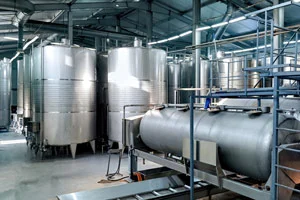A sensory evaluation of wine while it is undergoing treatment with wood makes it possible to control its properties in a suitable environment. Properly performing the evaluation involves aspects such as the room where the wine tasting is to be carried out, the preparation of samples or the use of glasses that comply with ISO 3591. This provides reliable data that help make informed decisions when preparing them.
What to consider to properly conduct a sensory evaluation of wine during wood treatment?
This analysis is a great help for winemakers when making major decisions that will determine some of the most important properties of the wine. Sensory evaluation during the aging process is vital to assess the effect of the contact between the wine and the wood and thus determine the ideal contact time to achieve the desired sensory profile and the correct evolution of the wine.
Color
The tasting sheet will show the effect of wood, especially on the color of red wines. This is due to the combination of tannin and anthocyanin, the micro-oxygenation that occurs during the barrel aging process causes the formation of acetaldehyde. This compound acts as a bridging molecule, favoring the union between anthocyanins and tannins, which causes a gradual decrease in astringency and favors color stability in the wine.
Wine structure
In terms of structure, tannins continue to play an important role. Wood provides non-volatile compounds (mainly phenolic acids and ellagic tannins) that will contribute to the astringency, bitterness and color stability of the wines. These compounds will favor the copigmentation reaction and will have an antioxidant effect against anthocyanins.
An increase in the wine’s fruity expression and a decrease in its vegetal nature
Wood also helps reduce the vegetal nature of the wine. The reduction of the vegetal nature of the wines is mainly due to the micro-oxygenation of the barrel, as the oxidation of thiol and pyrazinic compounds that contribute to the herbaceous characteristics of the wines takes place.
Aromatic adjustment and complexity
Aromatic expression is a fundamental element of sensory evaluation of wine. Its aromatic palette comes from the wood itself. These are the different compounds provided by wood:
- Furanic aldehydes: roasted almond aromas
- Volatile heterocycles: caramel/toasted aromas
- Phenolic aldehydes: aromas associated with vanilla
- Volatile phenols: toasted, spicy, wood, smoke.
- Lactones: coconut, vanilla aromas.
Recommended reading: What are the benefits of fining tannins?
Why is it important to conduct this evaluation?
Conducting a sensory evaluation of wine allows us to obtain information that can be used at different stages in wine production and marketing. Some of its most outstanding applications are:
- Detecting sensory defects and their causes.
- The results of the sensory evaluation expressed in a tasting card are connected and complemented with the analytical results and allow professionals to make the most suitable decisions regarding the oenological plans to be carried out.
- Determining product properties, such as astringency or oxidation level, so that it can be sensorially differentiated from another wine.
- Knowing consumers’ organoleptic preferences, adapting wines to their requirements or developing new ones.
- Select and train teams of tasters and validate panels of sensory judges.
- Calculating the price of a wine based on the quality as perceived by consumers.
- Organize consumer preferences to define sales niches and differentiate according to consumer profiles (education, habits, etc.).
Therefore, we can say that a wine tasting is a great source of information about the wine undergoing sensory evaluation and the type of consumer it is intended for.
What would be the best possible evolution?
The expressions of wood during fermentation vary significantly depending on how the fermentation is carried out and the settling times required for each format: powder, staves, chips or barrels. Therefore, decisions must be made based on the results of the tasting carried out during the treatment.
It is essential to consider the desired style of wine, the profile of the grape used and the quality of the wood to be used. In any case, it is true that the winemaker must make decisions based on the results of the sensory evaluation of the wine to make the appropriate changes at any given moment to correct the errors detected and even improve the perceived nuances.
Agrovin helps companies to conduct sensory evaluation of their wines and advises them along the process to obtain the desired results.


